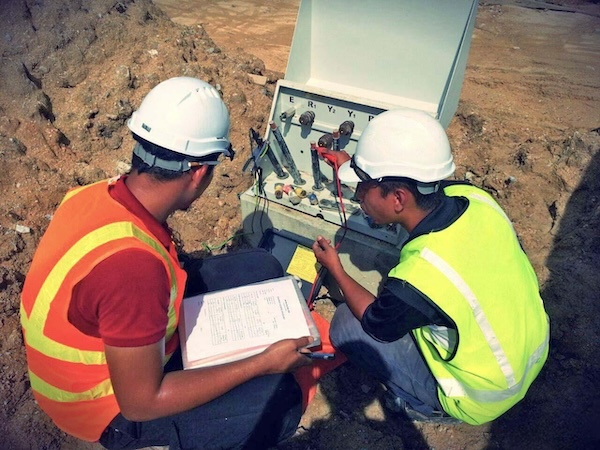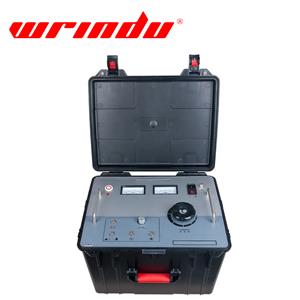How to find cable faults?
To solve cable faults, researchers and developers have created a cable fault tester based on the principle of "pulsed discharge method". Our company, Wrindu, specializes in the production and sales of cable fault testing equipment. We offer a comprehensive solution for power cable faults with our RDCD-I Cable Fault Testing System, which includes a cable fault locator, a cable test high-voltage signal generator, a cable fault pinpointing device, and an intelligent underground pipeline detector. You can purchase these devices individually or as a complete set.

The method for testing cable faults with this equipment involves three steps:The first step is to measure the distance with the locator.
Firstly, it is necessary to determine whether the cable fault is a high-resistance or low-resistance fault, or a grounding fault, and then adopt different testing methods accordingly. For grounding faults, the locator uses the low-voltage pulse method to measure the distance. For high-resistance faults, the high-voltage impulse discharge method is used to measure the distance, which requires many auxiliary devices such as high-voltage pulse capacitors, discharge spheres, current-limiting resistors, inductance coils, and signal samplers. The operation is complicated and unsafe, with a certain level of risk.
Moreover, it is necessary to analyze the sampled waveforms, which requires a high level of knowledge from the tester.
The second step is to find the cable path (this step can be omitted if the path is clear).
When searching for the path, a signal is applied to the cable with a path signal generator, and a receiver is used to pick up this signal. By tracing the path with the signal, the cable's path is determined. However, this method has a range of approximately 1-2 meters and is not very accurate.
The third step is to pinpoint the fault location based on the measured distance.
This step relies on the sound of the discharge produced by the fault. When the sound is loudest in the headphones of the pinpointing device, the fault location is found. However, since this method relies on sound, it is greatly affected by environmental noise, and the search can be time-consuming. Sometimes, it may only be possible to perform the test at night. When dealing with cross-linked cables, the process can be even longer because the cables typically have internal discharge with very low sound levels, making them almost inaudible. In the end, one may have to rely on measurements. This method can solve most power cable faults with oil-impregnated paper as the insulating material. However, for cable faults with cross-linked and polyethylene materials as the insulating material, which have appeared in recent years, the testing results are not very satisfactory.

The reason is that the sound produced by the discharge is often very faint (the cable sheath is not damaged, only internal discharge occurs). In such cases, other methods must be used to solve the fault. Despite these shortcomings, the cable fault testers designed based on the "pulsed discharge method" have solved many cable faults for enterprises over a long period and have been generally accepted by the industry. Their contributions are well-recognized and have been widely used in various industries. With the rapid development of various industries, the use of cables has become more widespread, and the types of cables have continued to increase, making cable faults inevitable. We know that different industries have different cable grades, usage environments, wiring and distribution methods, and insulation requirements.
Therefore, the characteristics of cable faults vary greatly due to the many factors that can cause cable failures. However, people often want to use one method to solve all cable faults due to past habits, which is why testers based on the "pulsed discharge method" still dominate the market. Nevertheless, using the "pulsed discharge method" to solve cable faults in some industries can yield no results and may even have serious consequences. For example, it is not suitable to directly use this method for cable faults in street lighting or underground cables in mining. Similarly, cables used in other industries have their own unique characteristics, which we will not discuss in detail here. However, with the continuous development of science and technology, we should be able to find simpler testing methods, classify cable faults, and treat them accordingly.
This approach will reveal that some cable faults do not require the "pulsed discharge method" for solutions, and finding these solutions can be convenient and quick. In our many years of practical work, we have found that there are many differences between high-voltage and low-voltage cable faults.
High-voltage cable faults are mainly operational faults, and most of them are high-resistance faults, which are further divided into leakage and flashover types; while low-voltage cable faults only have three conditions: open circuit, short circuit, and breakage (of course, these three conditions also apply to high-voltage cables).
Additionally, low-voltage cables have the following characteristics in actual use:
The randomness in laying is relatively large, and the path is not very clear;
Unlike high-voltage cables, which are buried deep after being filled with sand and bricks, low-voltage cables are buried shallowly and are prone to damage from external forces, leading to faults;
Low-voltage cables are generally shorter, ranging from dozens to hundreds of meters, unlike high-voltage cables that can extend to hundreds to thousands of meters.




